|
Power
Stroke shock boot seal The Pro-Line Power Stroke shocks have
rubber boots installed to keep the shock shafts and seals clean.
Unfortunately, the boots are not secured to the rod ends on the By-Pass
shocks because they do not use springs or retainers. Use a small zip-tie to
secure the bottoms of the boots to the shock-shaft rod ends. The zip-tie
will prevent the boot from slipping off the rod end. |
 |
|
Improved
fuel-tank lid seal The quick-fill caps on some fuel tanks won't
close or seal completely when the rubber O-ring inside the cap is new or
just dry. Some lids are adjustable; if yours isn't, apply a little grease to
the O-ring to allow the cap to close completely and provide a better seal. |
 |
|
Vent for
better handling The vent holes drilled into most monster truck
rims are too small, so they don't allow the air to vent out fast enough when
the vehicle lands from a jump or runs over obstacles. This can cause the
tires to bounce excessively when going over bumps (instead of absorbing the
impacts), which leads to erratic handling. Enlarging the holes slightly or
drilling a few more similar size air-vent holes will help the air escape
faster, and that will improve your truck's handling. A tapered reamer works
great for enlarging the vent holes in the plastic rims. |
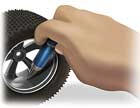 |
|
Glitch
Less Radio glitches are frustrating. If you've checked all of the
radio components and you still have problems, try twisting the negative and
positive wires that travel from the ESC to the motor around each other. Both
wires produce electrical noise that causes interference, but if you twist
them together, each cancels out the glitch-causing effect of the other to
reduce or even eliminate the problematic noise. |
 |
|
Super-secure tuned pipe Tuned pipes are notorious for coming off
the pipe hanger, especially during long Mains. In addition to applying
thread-lock to the setscrew that secures the pipe to the hanger, slide an
1/8-inch linkage collar (available from Du-Bro) onto the pipe hanger as an
extra precaution. Slide a few O-rings between the pipe and the collar for
additional shock protection. |
 |
|
Easy
Synthesized Receiver Access If your car uses a plastic box to
protect the receiver and you have one of the new synthesized receivers, this
tip is for you. Instead of disassembling the box whenever you need to change
channels, install a hinged screw cover for easier access to the receiver
dials. They are found in most hardware stores. Drill a hole into the
receiver box that�s large enough for the cover and so it lines up with the
receiver dials, then glue it in place. When you need to change the setting
on the receiver, just flip open the screw cover. |
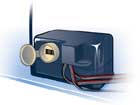 |
|
Easy-access camber adjustment Dish wheels look great, but they
make adjusting camber on vehicles with pivot-ball suspensions impossible;
you have to remove them. Using a tapered reamer, make a hole that allows you
to pass a hex wrench through the wheel and access the pivot balls to make
quick and easy camber adjustments. |
 |
|
Clean
with agitation Electric jewelry cleaners are great for cleaning
small parts such as bearings and clutch components. The vibrating action
works well to remove dirt and built-up gunk. The basket holds the parts and
keeps them away from the dirt that falls to the bottom. For best results,
fill the trough with jewelry cleaner or WD-40. |
 |
|
Neatness
counts Instead of using nylon zip-ties that have to be cut and
replaced when you need to do maintenance, use the plastic bindings that are
used on small booklets. You can buy them at a stationery store. Simply cut
them to the length you need and glue them into the chassis. You'll now
easily be able to add or remove wires. |
 |
|
Secure
your servos Run rubber grommets on your nitro vehicle's servos.
They will reduce the likelihood of damage to the case ears, they'll decrease
vibration, and they'll also help to prevent glitching. |
 |
|
Protective-film body repair Associated's clear protective film
(item no. 6312) also works great to repair cracks and holes in Lexan bodies.
Just cut a piece out and stick it on the crack in the body. The film will
last a long time, and one sheet can be used to repair many bodies. |
 |
|
Prevent
clutch slippage After rebuilding a new clutch and replacing the
bearings, clean the grease out of the rear bearing (closest to the clutch)
with motor spray. Also, blow out the bearing with an air compressor if you
can. This will greatly reduce the life of that bearing, but it will prevent
the clutch from slipping because the grease was thrown out of the bearing
during the first few tanks after you replaced it. |
 |
|
Foam
toolbox liners High-density foam works great for lining your
toolbox drawers. The lining will protect your tools, parts, or whatever else
you keep in your toolbox during transportation. Cut the foam to size, and
install a piece in each compartment. Pick up big sheets of high-density foam
at a hardware store or at Wal-Mart for less than $5 per sheet. |
 |
|
Cheap and
effective circle cutter You can make a circle cutter from a
99-cent school-supply compass and a no. 11 hobby knife. Install the hobby
knife in the clamp where you would normally put a pencil. Pass a screw
through the graduated scale, and secure the screw with a nut on the other
side. Once you have the compass set to the desired radius, tighten the nut
to hold the setting while you cut. Perfect for cutting out cooling holes on
bodies. |
 |
|
Transponder number reminder Store your AMB personal transponder
numbers in your cell phone�s address book for easy access. You always have
your cell phone in your pocket, so you'll be ready with your transponder
number when the race director asks you for it. |
 |
|
Easy
sticker-residue cleaner Use Duck Adhesive Remover, available at
most shipping stores, to remove leftover sticker residue, tire marks,
Sharpie marker outlines and just about anything that sticks to a Lexan body. |
 |
|
Avoid
screw screw-ups To make sure you don't mix up the hardware when
you take your car or truck apart for maintenance, put the screws back in the
parts as you remove them. No more wondering which screw goes where. |
 |
|
Non-stick
scissors To prevent servo-tape residue from sticking to your
scissors, wet the blades before you cut the tape. |
 |
|
Glow-plug
grabber A glow plug can fall out of the socket and be damaged
when you remove it with a socket wrench. To prevent this from happening, cut
a 2mm slice of fuel tubing, and put it into the wrench, as shown; secure it
with a little Shoe-Goo. Now, the tubing will grab the glow plug and prevent
it from falling out. |
 |
|
Easy
engine-cooling scoop Venting your vehicle's Lexan body is a great
way to help an engine run cooler, but holes in the windshield don't look
scale. Instead, cut a scoop on the top of the body in front of the engine.
Draw a rectangle, and then cut along three of its four sides. Make a flap by
bending the Lexan downwards to direct air to the engine, as shown. |
 |
|
Stay-put
fuel line If the fuel line on your nitro vehicle keeps slipping
off the fuel-tank pick-up, double up the end of the fuel line. Slide a 3mm
length of fuel line over the jaws of a pair of needle-nose pliers. Next,
spread the piece of line, and slide it over the end of the fuel line that
goes to the tank pick-up. The fuel line will be clamped into place. |
 |
|
Homemade
nitro cleaner You can make your nitro-car cleaner easily and
affordably by mixing two parts denatured alcohol with one part Simple Green.
Store the cleaner inside a pump spray bottle, and top off the brew with a
capful of WD-40. Be sure to shake the bottle before every application
because the solvents separate over time. One gallon of denatured alcohol and
a 2-liter bottle of Simple Green will make enough nitro cleaner to last
months. |
 |
|
Multiple
car setups with one radio Most computer radio systems have
multiple model memories for storing setups. You can also use the
model-memory feature to store different setups for just one vehicle. For
example, have one model profile setup for asphalt and another for racing on
carpet. Off-road racers can store setups for a variety of surfaces. |
 |
|
Magnetized screwdriver tip Some screws must be installed in
places on your RC model that are hard to reach. To make wrenching easier,
rub the tip of the screwdriver along the side of an electric motor. The
powerful magnets inside the motor will magnetize the tip of the screwdriver,
so the metal screws will stick to it. |
 |
|
Fuel-line
shock cushions To protect your shocks from damage when landing
off big jumps, slide 2 to 3mm lengths of silicone fuel line over the shock
shafts. The fuel line will prevent the shock pistons from ramming into the
bladders inside the shocks. |
 |
|
Ziploc
air-filter holder Pick up a few spare air-filter elements and
store them in a Ziploc bag. Pour air-filter lube into the bag, and you'll
always have filters ready when you go racing. The oil won�t leak out, so you
won't end up with a mess in your toolbox. Use the bag only to store clean,
lubed filters. |
 |
|
Fuel-tubing shock bushing If you lose the plastic or metal shock
bushing in the shock cap, substitute a 3mm slice of fuel tubing. |
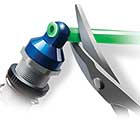 |
|
Cheap
exhaust-tip plug To prevent oil and fuel from spilling out, use a
foam earplug as an exhaust-tip plug. Push it into the exhaust tip after
you've finished running your vehicle for the day, and you won't have to
worry about spilling fuel and oil and making a mess. |
 |
|
Revive
your Dremel tool bits Dremel sanding drums and tool bits can
easily become glazed and dulled with normal use, especially if you grind a
lot of plastic and Lexan. These materials melt quite easily from the
friction of the sanding, and that can leave a mess of melted plastic on the
drum. I've seen racers throw away those bits, and that is a waste. You can
usually bring a Dremel bit back to life by grinding the surface with a
diamond-faced file (available at most hardware stores). Install the bit on
the Dremel, and spin it at 3/4 speed. Use the file to remove the glazed-over
sections or melted plastic. |
 |
|
Secure
antenna routing The antenna leads on most 75MHz receivers are
longer than the antenna tubes that are provided with most RTRs. Extra wire
sticking out of the antenna tube not only looks hack, it also exposes the
antenna to damage. For a cleaner and more secure installation, cut 2mm off
the open end of the rubber antenna cap, feed the antenna lead through the
tube, and secure the extra wire to the outside of the antenna tube with the
ring that you just cut. Then slide the endcap over the tip of the antenna. |
 |
|
Better
receiver seal Dirt that accumulates inside your receiver can
cause glitching. Open your receiver's case, shake out the dirt, and then
close it. Seal the receiver case's seam with tape. Also cover the unused
third channel or battery slot (if you run an electric car) with a clear
piece of decal material or tape. This tip is also good for speed controls;
you'd be surprised how much dirt can get in through the setup-button
opening. |
 |
|
Easy-access module tool Colin attaches a small plastic
screwdriver to the antenna on his Hitec CRX radio system (as shown) with a
couple of loose-fitting zip-ties. This makes it easy for him to grab the
screwdriver when he wants to adjust the frequency pots on the side of the
Hitec Spectra module. |
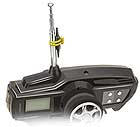 |
|
Laminated
setup sheet Blake laminates his setup sheet and then writes his
setup info on it with a Dry Erase marker so he can use the sheet over and
over again. When you find a setup that's a keeper, just photocopy it. Any
print shop will laminate your racer sheets for a small charge. |
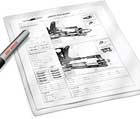 |
|
More
secure preload adjusters Threaded-body shocks are very cool and
easy to adjust, but the preload collars on some of those shocks have a
tendency to �drift� and change the preload setting while you�re driving.
Install preload clips above the knurled preload adjusters to prevent the
collars from moving and changing your settings. |
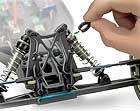 |
|
Q-Tips
tips Cotton swabs are a great addition to your toolbox. You can
use them to clean hard-to-reach areas on your car, like around the base of
the carburetor and between wheel spokes. |
 |
|
I'm
glovin' it To keep your hands clean while wrenching, painting
bodies and gluing tires, wear latex gloves just like the full-scale auto
mechanics do. Latex gloves are available at most hardware stores, and five
bucks will get you approximately 25 pairs of gloves. |
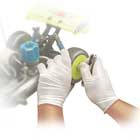 |
|
Zip-tie
preload spacers Zip-ties make great preload spacers if you don't
have enough clip-on spacers to properly adjust the preload on your shocks.
Simply attach zip-ties around the top portion of the shock just above the
spring retainer. Install the preload clips below the zip-tie to fine-tune
your vehicle's ride height. |
 |
|
Body-mount cushions Installing foam cushions on the body posts
will protect the body during crashes. It will also make your car or truck
more quiet when going through the rough stuff because the body won't rattle.
Novak speed controls include a foam packing that works perfectly. Cut the
foam into four small 1/2x1/2-inch squares, and then make a hole in the
centers so you can slide them over the body posts. |
 |
|
Turnbuckle tamer If your turnbuckle doesn't have a notch to
indicate which side has the left-hand thread, just slip a ring of silicone
insulation from a scrap of speed-control wire over the turnbuckle on the
appropriate side. Now, when you remove a turnbuckle, you can easily identify
which end is which when you reinstall it. |
 |
|
Cheap and
convenient pit caddy Small plastic tool caddies like the one
shown here are perfect for hauling your nitro support gear from the pits to
the track. Most tool caddies have two or three compartments to store your
glow-plug igniter, temp gun, shaft starter or EZ-Start, fuel bottle, tools,
extra glow plugs and more. I picked up my caddy at the local hardware store
for less than $4. |
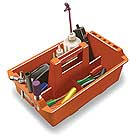 |
|
Manual
throttle mod Any racer knows that turning on your radio in the
pits is strictly forbidden, but in order to tune your nitro mill properly,
you need to operate the throttle. The solution: make a manual throttle by
using a long piece of throttle rod that's bent at a 90-degree angle. Tug on
the upturned end with your finger, and you can actuate the carb without
moving the throttle servo. |
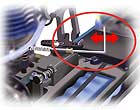 |
|
Cup-holder fuel caddy A cut-down cup holder or a foam drink cozy
glued or pop-riveted to the side of your pit box makes a great caddy for
small fuel bottles. For larger bottles, use a bicycle water-bottle cage. |
 |
|
On my
Mark It's always a good idea to stop your engine with the piston
at the bottom of its cycle, so when the engine cools and slightly contracts,
the tapered sleeve won't squeeze the piston at the top and ruin the engine's
close tolerances. To know when your piston is at the bottom of its cycle,
remove the glow plug and turn the engine over manually until the piston
travels down. Then mark the flywheel with a solid line at the bottom. Do
this once, and you'll always know when the piston is in the proper position. |
 |
|
Hold
Tight A fuel line popping off can end your day at the races. To
prevent this, place a 1/2-inch section of heat-shrink tubing over the fuel
line before you attach it. Then slip the fuel line and tubing onto the
nipple and shrink it for a nice snug fit. |
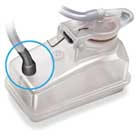 |
|
Safe
Window Openings It's common practice to cut out windows and holes
for ventilation or to gain access into nitro bodies. The sharp edges of a
Lexan body can deliver a nasty scratch or even cut a crew member's finger as
a car speeds in and out of the pits. To keep your digits safe, line the
openings with fuel line. Just slit one side of the tubing and press it onto
the exposed edge, and use a bit of glue to secure it. |
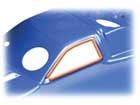 |
|
Manual
Minder Being organized is always a good thing, so every time you
get a new RC car, three-hole punch the instruction manual and put it in a
three-ring binder. Do the same to any supplemental sheets (such as parts
lists). If you race, photocopy your setup sheets, and put them in a separate
section of the binder. |
 |
![]()